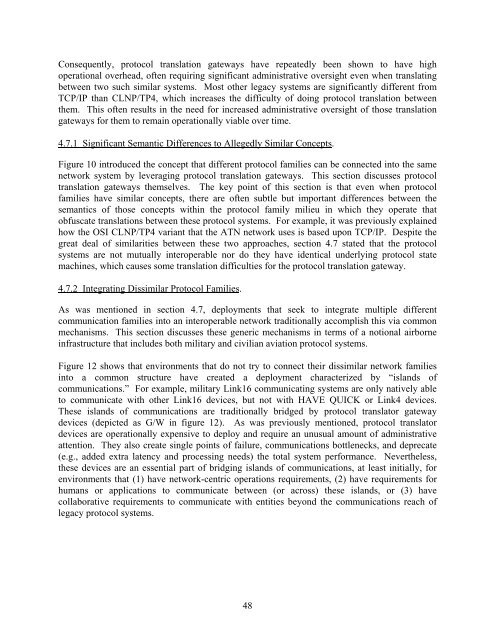Local Area Networks (LANs) in Aircraft - FTP Directory Listing - FAA
Local Area Networks (LANs) in Aircraft - FTP Directory Listing - FAA
Local Area Networks (LANs) in Aircraft - FTP Directory Listing - FAA
Create successful ePaper yourself
Turn your PDF publications into a flip-book with our unique Google optimized e-Paper software.
Consequently, protocol translation gateways have repeatedly been shown to have high<br />
operational overhead, often requir<strong>in</strong>g significant adm<strong>in</strong>istrative oversight even when translat<strong>in</strong>g<br />
between two such similar systems. Most other legacy systems are significantly different from<br />
TCP/IP than CLNP/TP4, which <strong>in</strong>creases the difficulty of do<strong>in</strong>g protocol translation between<br />
them. This often results <strong>in</strong> the need for <strong>in</strong>creased adm<strong>in</strong>istrative oversight of those translation<br />
gateways for them to rema<strong>in</strong> operationally viable over time.<br />
4.7.1 Significant Semantic Differences to Allegedly Similar Concepts.<br />
Figure 10 <strong>in</strong>troduced the concept that different protocol families can be connected <strong>in</strong>to the same<br />
network system by leverag<strong>in</strong>g protocol translation gateways. This section discusses protocol<br />
translation gateways themselves. The key po<strong>in</strong>t of this section is that even when protocol<br />
families have similar concepts, there are often subtle but important differences between the<br />
semantics of those concepts with<strong>in</strong> the protocol family milieu <strong>in</strong> which they operate that<br />
obfuscate translations between these protocol systems. For example, it was previously expla<strong>in</strong>ed<br />
how the OSI CLNP/TP4 variant that the ATN network uses is based upon TCP/IP. Despite the<br />
great deal of similarities between these two approaches, section 4.7 stated that the protocol<br />
systems are not mutually <strong>in</strong>teroperable nor do they have identical underly<strong>in</strong>g protocol state<br />
mach<strong>in</strong>es, which causes some translation difficulties for the protocol translation gateway.<br />
4.7.2 Integrat<strong>in</strong>g Dissimilar Protocol Families.<br />
As was mentioned <strong>in</strong> section 4.7, deployments that seek to <strong>in</strong>tegrate multiple different<br />
communication families <strong>in</strong>to an <strong>in</strong>teroperable network traditionally accomplish this via common<br />
mechanisms. This section discusses these generic mechanisms <strong>in</strong> terms of a notional airborne<br />
<strong>in</strong>frastructure that <strong>in</strong>cludes both military and civilian aviation protocol systems.<br />
Figure 12 shows that environments that do not try to connect their dissimilar network families<br />
<strong>in</strong>to a common structure have created a deployment characterized by “islands of<br />
communications.” For example, military L<strong>in</strong>k16 communicat<strong>in</strong>g systems are only natively able<br />
to communicate with other L<strong>in</strong>k16 devices, but not with HAVE QUICK or L<strong>in</strong>k4 devices.<br />
These islands of communications are traditionally bridged by protocol translator gateway<br />
devices (depicted as G/W <strong>in</strong> figure 12). As was previously mentioned, protocol translator<br />
devices are operationally expensive to deploy and require an unusual amount of adm<strong>in</strong>istrative<br />
attention. They also create s<strong>in</strong>gle po<strong>in</strong>ts of failure, communications bottlenecks, and deprecate<br />
(e.g., added extra latency and process<strong>in</strong>g needs) the total system performance. Nevertheless,<br />
these devices are an essential part of bridg<strong>in</strong>g islands of communications, at least <strong>in</strong>itially, for<br />
environments that (1) have network-centric operations requirements, (2) have requirements for<br />
humans or applications to communicate between (or across) these islands, or (3) have<br />
collaborative requirements to communicate with entities beyond the communications reach of<br />
legacy protocol systems.<br />
48
















